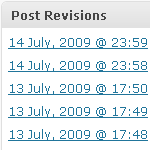How to Use WordPress Revisions to Go Back in Time
By default, all your Posts and Pages save revisions of themselves as you are writing them and editing them. This can really save your butt if you accidentally change or delete something you shouldn’t have and have no other copy. This is a quick overview of how to use this powerful feature of WordPress.
Editor’s note: 404 link removed.

Awesome Image-Attachment Recipes for WordPress
Recently, I found myself on the front lines of WordPress’ somewhat complicated Media-Library system. The site that I was developing required a rather elaborate system of retrieving and displaying image attachments. So, using the latest version of WordPress (2.8.3 at the time), I found myself experimenting with as many template tags and custom functions as I could find. After much experimentation, I discovered the perfect solution, and along the way I collected a healthy collection of recipes for displaying image attachments and their various types of associated information.

Show Off Your WordPress Database Statistics
Hello WordPress peeps! Did you know that WordPress makes it super-easy to display some basic statistics about your database performance? The information may be displayed publicly on your web page, slightly hidden in your source code, or entirely private so only you can see it. There are two basic statistics that are drop-dead easy to include on your pages:

Goodbye Dolly? (Take the poll!)
Out of the thousands of plugins available for WordPress, there is one that all WordPress users are familiar with: Hello Dolly. As far as I know, the Hello Dolly plugin was the first WordPress plugin and has been included with every version of WordPress. The plugin is so familiar that many WordPress users don’t even think about it. They either activate the plugin or delete it without giving it a second thought. But if you actually stop to think about it for a moment, the following questions seem inescapable:

3 Ways to Monitor PHP Errors
Close monitoring of your site’s PHP errors is crucial to operating a healthy, secure, and well-performing website. When left undetected, PHP errors can reduce performance, waste bandwidth, and leave your site vulnerable to malicious attack. PHP errors usually occur unpredictably and spontaneously, and may be triggered by even the slightest changes to your server configuration, database setup, or WordPress files. Even if your site appears to working properly on the surface, it may in fact be suffering from undetected PHP errors that should be fixed as soon as possible.

Mastering WordPress Post-Revisioning and Auto-Save Features
Not everyone loves the post-revisioning feature of WordPress. In fact, some people can’t stand it. On the one hand, it’s nice to have a library of post-draft revisions to drudge through if you should ever make a mistake. On the other hand, multiple copies of every post is a great way to bloat your database with otherwise useless information.

How to Remove the WordPress Version Number
In this DigWP tutorial, we take a look at a the potential security risk inherent in displaying your site’s WordPress version number to anyone or anything that happens to stop by for a visit. For anyone who has been working on securing their WP-powered website, one of the most commonly seen security tips around the WordPress-o-Sphere has got to be this:

Delicious Recipes for WordPress Page Menus and Page Listings
There are so many awesome ways to display your WordPress pages. Out of the box, WordPress provides two different template tags for displaying lists of your site’s pages. The first, most-commonly used tag is wp_list_pages(), and the second, lesser-known tag is wp_page_menu(). First we’ll explore the highly flexible wp_list_pages() template tag, and then we’ll dig into the new wp_page_menu() tag. Along the way, we’ll check out some delicious recipes, tips and tricks for creating the perfect WordPress Page Menu.

Optimize WordPress Performance with wp-config.php
As you may recall, there are a ton of configuration tricks available for the WordPress wp-config.php file. So many in fact, that I think many people may have missed some of the choice definitions aimed at optimizing WordPress performance. In this post, we’ll explore the best ways to improve your site’s performance with WordPress’ wp-config.php file.
How to Design a Tumblelog Theme for WordPress
Tumblelogs are a great way to streamline mixed-media blogging for different types of content. Commonly used tumblelog topics include “Links”, “Photos”, “Quotes”, “Dialogue”, and “Video”. A good tumblelog presents each these different topics with its own unique format while retaining an overall sense of cohesion throughout the entire design.

Free HTML5 WordPress Theme
In an effort to inspire more WordPress theme designers to embrace HTML5, I am releasing the “H5” Theme Template. The H5 Theme Template is a bare-bones WordPress theme built entirely with HTML5 and styled with some basic CSS 3.0.
As you may know, HTML5 provides greater flexibility and interoperability than previous markup languages, and enables us to build well-structured themes that are more flexible, interactive, and semantically precise. So using it to build awesome WordPress themes is a no-brainer.

WordPress Configuration Tricks
Many WordPress users know the wp-config.php file as the key to the WordPress database. It is where you set the database name, username, password, and location (among other things like security keys, database prefix, and localized language).
Here’s a screenshot of wp-config.php (aka the WordPress configuration file) for those who may not yet be familiar:

The xmlrpc.php File and Site Security
Included in the header.php template of most WordPress themes, there is an important hook called wp_head. This essential hook enables WordPress functions to output content to the browser in the <head></head> area of your web pages1.
For example, in newer versions of WordPress, wp_head() enables WordPress to output the following three lines to your theme’s <head></head>:

Add/Remove Buttons from WordPress Write Panel
One of the features of WordPress 2.8 was a “increased speed of the Admin area”, which cited compressed JavaScript files as the reason for the speed increase. One of those files that was compressed was the file quicktags.js in the /wp-includes/js/ directory.







